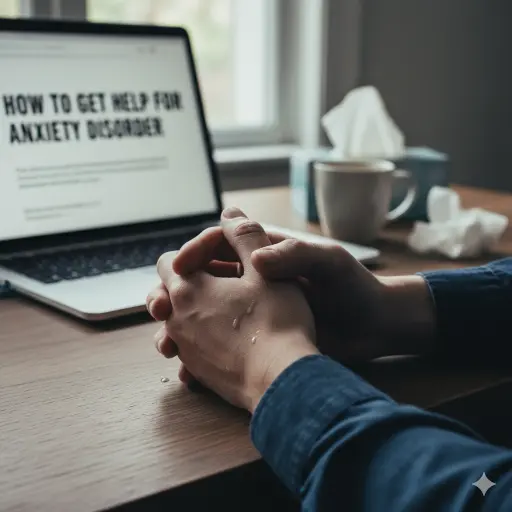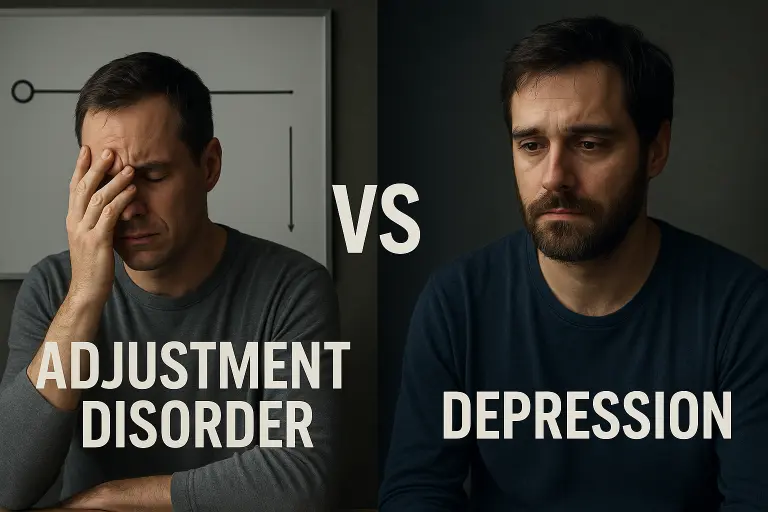Understanding What Is Adjustment Disorder: Symptoms & Solutions

Adjustment disorder is an intense emotional or behavioral response to a significant stressor that disrupts daily life. This article will explain what adjustment disorder is, its symptoms, causes, types, and available treatments.
Key Takeaways
- Adjustment disorder is an emotional or behavioral response to identifiable stressors, characterized by symptoms that disrupt daily functioning and arise within three months of the triggering event.
- Common symptoms include emotional distress, behavioral changes, and physical manifestations, with distinct subtypes categorized based on the predominant emotional response.
- Effective treatment options include various forms of therapy, medication management, and mindfulness practices, while early intervention is crucial to prevent complications such as substance abuse and suicidal ideation.
Defining Adjustment Disorder
Adjustment disorder is characterized by an emotional or behavioral reaction to an identifiable stressor, such as a major life change or a traumatic event1. This reaction can manifest in extreme ways and affect thoughts, feelings, and actions.
For instance, a person may feel an overwhelming sense of sadness, anxiety, or hopelessness following a stressful event.
One key aspect of adjustment disorder is that the severity of symptoms often surpasses what is typically expected in response to the triggering event.
These symptoms can significantly impair an individual’s ability to function socially and at work. According to the Diagnostic and Statistical Manual of Mental Disorders (DSM-5)2, a crucial criterion for diagnosing chronic adjustment disorder is that symptoms arise within three months of the stressor.
Recognizing adjustment disorder helps differentiate it from a temporary reaction to stress. Early identification allows individuals to seek appropriate help and support, preventing further emotional or behavioral complications.
Common Symptoms of Adjustment Disorder
Adjustment disorder symptoms can vary widely, but common emotional reactions include feeling sad, anxiety, and hopelessness. These emotional symptoms can make everyday tasks seem insurmountable, leading to a pervasive feeling of being overwhelmed.
Behavioral symptoms are also prominent in adjustment disorder. Individuals may exhibit impulsive or reckless behavior, such as sudden outbursts or risky actions.
Concentration difficulties can further complicate daily life. People might struggle to focus on work or school, leading to decreased performance and increased frustration, along with emotional or behavioral symptoms.
Physical symptoms often accompany the emotional and behavioral signs of adjustment disorder. Headaches, stomachaches, and insomnia are common physical manifestations.
Despite feeling fatigued, individuals with adjustment disorder may find it difficult to sleep, creating a cycle of exhaustion and stress.
These predominant symptoms collectively impact an individual’s ability to function, and recognizing and addressing them promptly is crucial. Knowing the range of clinically significant symptoms aids in identifying when professional help is needed to manage these challenges effectively.
Types of Adjustment Disorders
Adjustment disorders are categorized into six distinct subtypes2, each representing different emotional or behavioral responses to stressors.
The first subtype is adjustment disorder with depressed mood, characterized by pervasive sadness or hopelessness following a stressful event.
The second subtype, adjustment disorder with anxiety, involves excessive worry, restlessness, and physical symptoms such as heart palpitations. When symptoms of both anxiety and depression are present, it is classified as adjustment disorder with mixed anxiety and depressed mood, the third subtype.
Other subtypes include:
- Adjustment disorder with disturbance of conduct, where individuals may exhibit aggressive or defiant behavior
- Adjustment disorder with mixed disturbance of emotions and conduct, combining emotional symptoms with behavioral problems
- Adjustment disorder unspecified, which includes symptoms that do not neatly fit into these specific categories, including the above subtypes.
Untreated, these disorders can escalate into more serious mental health conditions like anxiety disorders, major depression, or illness.
Causes and Risk Factors
Adjustment disorders can develop in response to a variety of stressors, such as relationship issues, health problems, or significant life transitions.
Both positive and negative life events, including stressful life events, can serve as specific stressors, contributing to the development of adjustment disorders and stress-related disturbances. Experiencing multiple significant stressors simultaneously can elevate the risk.
Additionally, pre-existing mental health conditions like severe anxiety or depression can make individuals more susceptible.
Recognizing these causes and risk factors helps identify those at higher risk and implement preventive measures.
Diagnostic Process
To diagnose adjustment disorder, a comprehensive evaluation and interview are essential to assess the individual’s symptoms and stressors. A mental health professional, typically a child and adolescent psychologist or a qualified therapist, conducts this evaluation, especially in children and adolescents.
Preparation for a mental health appointment can include listing symptoms, significant life changes, and any coping strategies that have been attempted. This thorough assessment helps in accurately diagnosing adjustment disorder and differentiating it from other mental health conditions.
What Are the Treatment Options for Adjustment Disorder?
Treatment options for adjustment disorders are diverse, including talk therapy, medication management, and holistic methods. Cognitive Behavioral Therapy3 (CBT) is a key treatment, focusing on modifying negative thought patterns to improve emotional responses. ‘
Interpersonal Therapy4 (IPT) enhances social connections affected by significant life changes, providing essential support.
Group therapy fosters connections among individuals with shared experiences, helping to reduce isolation and build a support network through support groups. Medication management may also be an option for individuals requiring additional support to manage their social skills symptoms.
Mindfulness practices, such as deep breathing and meditation, can help manage stress and anxiety linked to adjustment disorders.
A holistic approach to care integrates physical, mental, and emotional therapies, offering comprehensive recovery.
Complications if Left Untreated
Untreated adjustment disorders can lead to serious complications, including substance abuse problems, as individuals may turn to drugs or alcohol to cope with their distress.
The likelihood of experiencing suicidal thoughts or behaviors increases significantly among those suffering from untreated adjustment disorders, potentially culminating in a suicide attempt.
Interestingly, unlike other mental health disorders, adjustment disorder symptoms typically resolve within six months once the stressor is removed. However, it is vital to address symptoms early to prevent these potential complications and ensure a healthier recovery.
Adjustment Disorder Prevention Strategies
Creating a consistent daily routine during times of change can provide individuals, especially children, with a sense of stability and security.
Encouraging open expression of feelings can help them feel understood and less isolated during difficult transitions. A crisis lifeline can also provide additional support.
Teaching healthy coping skills, like deep breathing exercises and physical activities, can help manage stress more effectively. Limiting exposure to additional stressors, such as negative thoughts, negative news, or high academic demands, can reduce overall stress during stressful events, especially when the stressor continues.
Maintaining physical health is essential in this process and can help prevent stress response syndrome.
Collaborating with educators can provide an additional support system for children dealing with adjustment disorders in the school environment.
When to Seek Help
Individuals experiencing significant marked distress from adjustment disorder should consult a mental health professional, especially if symptoms interfere with daily life.
Seeking support is crucial if emotional or behavioral issues emerge after a major life change or stressor.
Warning signs that professional help is needed include persistent feelings of hopelessness, overwhelming anxiety, and thoughts of self-harm or suicide. Consulting a healthcare provider can help identify other potential causes of symptoms that may resemble adjustment disorders.
How Grand Rising Behavioral Health Can Help
At Grand Rising Behavioral Health, we offer personalized mental health treatment Massachusetts that meets you where you are in your recovery journey. Our programs range from Partial Hospitalization for those needing the highest level of outpatient support, to Intensive Outpatient and Outpatient therapy for flexible, step-down care.
Each client works with our compassionate, licensed clinicians who use evidence-based therapies such as CBT, DBT, EMDR, and trauma-informed care to address symptoms and build lasting resilience.
Medication management is also integrated into treatment for those who need it, ensuring symptoms are managed effectively alongside therapy.
We tailor every treatment plan to reflect your unique stressors, strengths, and goals.
Beyond clinical therapies, we also incorporate holistic practices like mindfulness, stress-reduction exercises, and skill-building workshops, helping you develop healthier coping tools. This balance of structure and compassion makes our treatment effective for symptom relief, long-term recovery, and restored confidence.
Whether you’re facing new stressors, ongoing challenges, or the complications of untreated adjustment disorder, together, we will help you find both immediate relief and long-term tools to thrive.
Contact us today to schedule a confidential consultation.
Frequently Asked Questions
What are the common symptoms of adjustment disorder?
Common symptoms of adjustment disorder encompass sadness, anxiety, hopelessness, impulsive behavior, difficulty concentrating, and physical manifestations like headaches and insomnia. It is crucial to recognize these symptoms early for effective management.
What are the different types of adjustment disorders?
Adjustment disorders include six subtypes: with depressed mood, with anxiety, with mixed anxiety and depressed mood, with disturbance of conduct, with mixed disturbance of emotions and conduct, and unspecified.
Recognizing these subtypes is essential for effective treatment and support.
What causes adjustment disorder?
Adjustment disorder is caused by various stressors, including relationship issues, health problems, and significant life transitions, along with individual factors like genetics and temperament. Understanding these triggers is essential for effective support and intervention.
How is adjustment disorder diagnosed?
Adjustment disorder is diagnosed through a thorough evaluation and interview conducted by a mental health professional.
The professional assesses the individual's symptoms and stressors, ensuring an accurate understanding of the individual's condition.
What treatment options are available for adjustment disorder?
Adjustment disorder can be effectively treated through a combination of talk therapy, such as cognitive-behavioral therapy (CBT) or interpersonal therapy (IPT), medication management, holistic methods, mindfulness practices, and group therapy.
Choosing a treatment plan that best suits individual needs for optimal recovery is important.
Conclusion
Adjustment disorder is a complex mental health condition that can significantly impact one’s life. Understanding its symptoms, causes, and treatment options is crucial for managing it effectively.
By recognizing when to seek help and utilizing professional support like we offer at Grand Rising Behavioral Health, individuals can navigate their challenges and find a path to recovery. Remember, seeking help is a sign of strength, and support is always available.
Sources
- https://pubmed.ncbi.nlm.nih.gov/36822730/
- https://www.ncbi.nlm.nih.gov/books/NBK519704/table/ch3.t19/
- https://www.researchgate.net/publication/372232350_Evaluation_of_the_Effectiveness_of_Cognitive_Behavioural_Therapy_for_Patients_Suffering_From_an_Adjustment_Disorder
- https://pmc.ncbi.nlm.nih.gov/articles/PMC1414693/
More Resources
A team ready to start your journey.
Get in touch — today.
We are a safe space – a haven for exceptional individuals to receive discreet, personalized, in-person treatment and care.
.avif)










